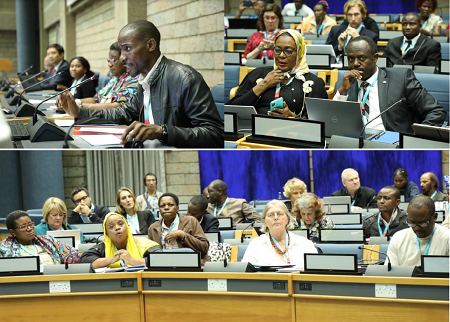UN Habitat Stakeholder Update

The long process toward the establishment of a stakeholder-engagement mechanism (SEM) for UN-Habitat Intergovernmental Meetings seeks to enhance the current practice by building on the proposals by stakeholders and the UN system-wide experience. As of January 2023, UN Habitat’s Executive Board Ad Hoc Working Group on the SEM reviewed three proposals from Habitat International Coalition, the UN Habitat executive director’s Stakeholder Advisory Group Enterprise (SAGE) and the now independently registered NGO General Assembly of Partners (GAP). Having reviewed those inputs and an internal review of UN System-wide experiences produced by UN Habitat’s Partnerships and Local Governments Unit (PaLGU)
At its eighth meeting on 7 December 2022, the Ad Hoc Working Group discussed the following three SEM options presented by the UN Habitat secretariat:
- Option one: Outsourced Option. This is similar to the Habitat III preparatory process; an external entity assumes the initiative to mobilize and engage stakeholders without secretariat involvement.
- Option two: Secretariat-Lite Option. Stakeholders are self-organized. The secretariat provides a neutral platform, organizes stakeholder meetings, and facilitates participation in the intergovernmental meeting and self-organized activities in conformity with the UN Charter and the Rules of Procedure.
- Option three: Enhanced Secretariat Option. The Stakeholder Advisory Group Enterprise (SAGE) would be enhanced to mobilize and consult with stakeholders, and relevant networks and advisory groups.
Option two has been strengthened in consideration of the three submissions from stakeholders, the UN Environment Programme (UNEP) practice and the discussions of the ad hoc working group.
In January 2023, the Working Group agreed upon the following SEM structure, expressed in a concept note:
- Based on the principle of self-organization, stakeholders will organize, coordinate, and develop their interventions and policy recommendations in accordance with the UN Charter and the Rules of Procedure.
- Stakeholders will elect members of a stakeholder coordination committee that will have a maximum of 42 members, two seats for each constituency group and a representative from each UN-Habitat region. The UN-Habitat secretariat will organize elections every two years. Elected members of the stakeholder coordination committee will serve for a maximum of two years. The committee will decide on the structure of its secretariat, its leadership, and the frequency of its meetings.
- The UN-Habitat secretariat will provide a neutral platform to convene stakeholder meetings. The secretariat will also facilitate the involvement of stakeholders in specific activities associated with the intergovernmental processes including facilitating with the UN Office at Nairobi (UNON) and other relevant partners to ensure stakeholders are able to secure rooms for side-events or other self-organized activities.
- The following existing platforms will be used by the stakeholder coordination committee to engage stakeholders:
- The Global Stakeholders Forum (GSF) held every four years in conjunction with the UN-Habitat Assembly (UNHA),
- Global stakeholder’s consultation (GSC) held annually before the last session of the UN-Habitat EB,
- Regional consultations (RC) every two years,
- Regular stakeholder briefings by the UN-Habitat Secretariat on preparations for UNHA, the EB, the Committee of Permanent Representatives (CPR), related Working Group meetings and other relevant sessions,
- A “stakeholder coordination committee” (SCC) regular consultations with internal.
In response, on 17 January, HIC generally endorsed the concept note’s proposed stakeholder-engagement mechanism, trusting that it reflects the needs of the UN-Habitat governance bodies and system. HIC found that the proposal so far seems to pursue a democratic process with the election of a SCC every two years, guided and supported by a neutral secretariat.
The questions of gender and regional balance, term limits and other details remain open, however, but may be left to the successive SCCs with, perhaps, the endorsement of the periodic Global Stakeholder Forum. However, those may be subjects of internal SEM governance to be determined in the spirit and process of self-organization.
The concept note’s reference to “constituency groups” would need more specificity. The minimum designation would likely be the established UN Major Groups, but could be further interpreted to include those Habitat Agenda Partners and constituency groups established within the former GAP. The EB should be able to clarify which configuration would meet its needs. However, it is hoped that the expanded model of the GAP constituencies would best serve the principles of inclusiveness and specificity of policy-related advice to UN-Habitat governance bodies.
The reference to a maximum of 42 SCC members, with two seats for each constituency group, suggests consideration of up to 21 constituency groups. In that case, the inclusion of a representative from each UN-Habitat region implies that such SCC representatives would be asked to provide policy input particular to both (1) a social/functional constituency and (2) geographical specificity. More than one configuration could be considered to arrive at the maximum number of 42.
For purposes of UNHA, EB and CPR procedures, the EB may want to further rationalize stakeholder inputs and rights to speak. It would seem reasonable to set the number of eligible SCC speakers to fewer than 42 within a single session.
The United Nations Environment Assembly model is a good one to adopt. That also would provide some uniformity for those state delegates and stakeholder organizations operating at Nairobi within both UN-Habitat and UNEP. That model would suggest also that UN-Habitat bear no fiscal role in resourcing the SCC, but only support its functions logistically.
Many details and further steps remain to be deliberated and decided, including internal SCC governance and setting up an operating SCC secretariat. Those would be the subjects of a timetable yet to be determined, but perhaps to be decided in the context of the next GSF (June 2023).
At its first meeting of 2023, on 27 March, the EB considered a draft UN-Habitat Stakeholder Engagement Policy and recommended that the UNHA consider the draft stakeholder engagement policy at its second session, 5–9 June 2023.
Photo: Scenes from the first UN Habitat Global Stakeholder Forum, May 2019. Source: UN Habitat.
|